Salmon pasta is a delicious and popular dish that combines the flavours of salmon with pasta and various other ingredients. It’s a versatile dish that can be made in different ways, depending on personal preferences.
Indulge your taste buds in a tantalizing blend of flavours with a salmon pasta recipe—a mouthwatering symphony that brings together the succulent taste of salmon and the comforting allure of pasta.
Whether you’re a seafood aficionado or simply seeking a delightful twist on classic pasta dishes, this article will guide you through a straightforward and satisfying salmon pasta recipe. Get ready to embark on a culinary adventure that will leave you craving more of this delectable seafood delight.

SEE ALSO:
- 9 Best Pasta Salad Recipe you Should Try Out
- Best Spaghetti Bolognese Recipes you should try (Quick and Easy)
- Delicious Tacos Recipe for Your Next Taco Tuesday
- How to make Sushi Burrito: Homemade Sushi Recipe
- Fish Curry Recipe
Salmon Pasta Recipe
This salmon pasta recipe is perfect for a quick and satisfying weeknight dinner or a special occasion when you crave a mouthwatering seafood pasta dish.
Ingredients required for Salmon Pasta
- 2 salmon fillets
- 1 tbsp olive oil, plus 1 tsp if roasting
- 175g penne
- 2 shallots or 1 small onion, finely chopped
- 1 garlic clove, crushed
- 100ml white wine
- 200ml double cream or crème fraîche
- ¼ lemon, zested and juiced
- ½ small bunch dill, finely chopped
Step by Step Instructions on how to make Salmon Pasta
- You can either steam or roast the salmon, depending if you want to turn the oven on or not.
- To roast, heat the oven to 200C/180C fan/gas 6, place on a baking tray, drizzle with oil and roast for 12 mins until opaque, and the flesh starts to flake when pressed.
- To steam, place the fillets skin-side down in a steamer and steam over a pan of simmering water for 8-10 mins until cooked.
- While the salmon is cooking, boil the pasta for 10 mins until al dente, then drain, reserving 100ml of the pasta water.
- Heat the oil on medium heat in a wide frying pan and fry the shallot for 6 mins until softened but not turning golden.
- Add the garlic and fry for a minute more until fragrant.
- Add the wine, bubble for a few minutes until reduced by half, then add the cream and season well. Bring to a very gentle simmer.
- Flake the cooked salmon into big chunky pieces, leaving the skin behind.
- Add to the sauce with the cooked pasta. Add the lemon zest, a squeeze of the juice and most of the dill. Add a splash of the pasta water to the sauce to coat the pasta if needed.
- Toss gently to keep the salmon in big pieces. Check the seasoning. If using double cream, you may need a squeeze of more lemon juice.
- Grind over some black pepper and scatter over the remaining dill. Serve with a green salad.
READ ALSO: Biscoff Cheesecake Recipe
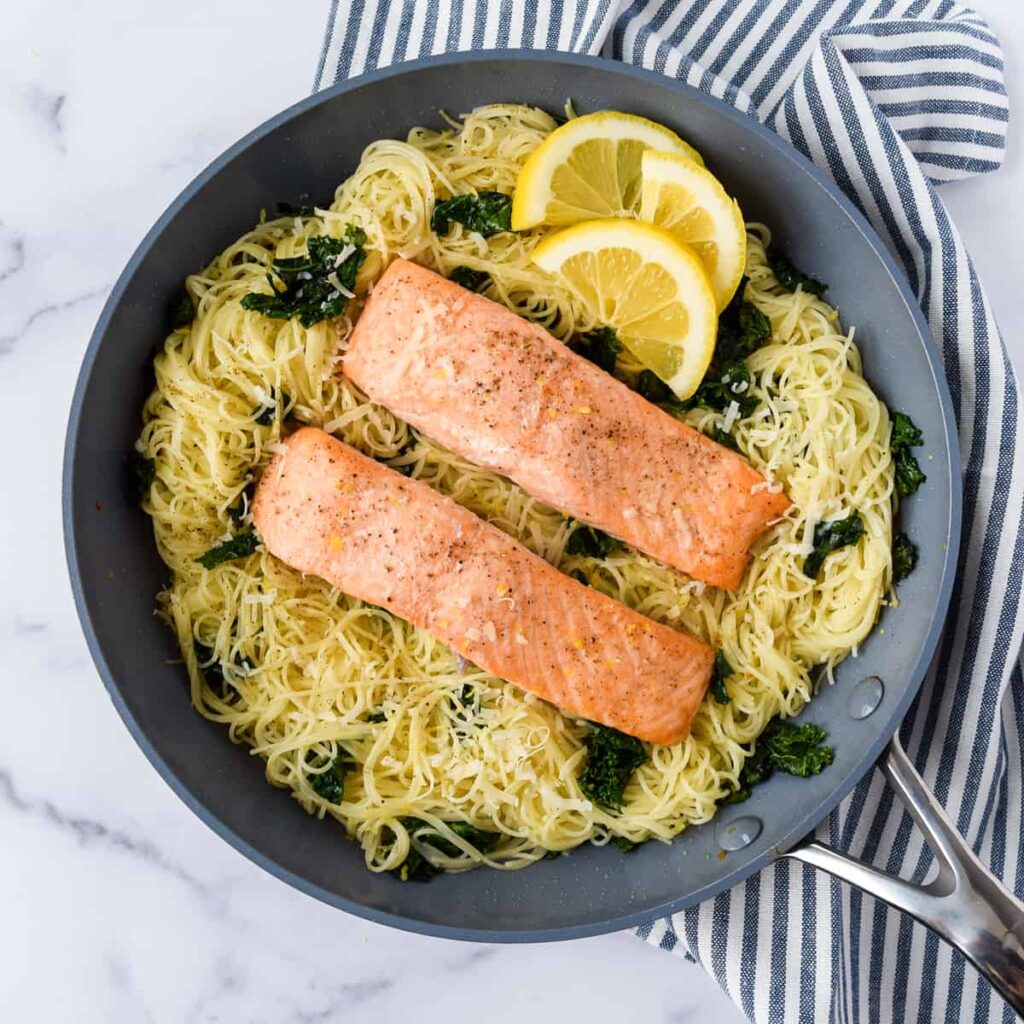
Tips and Tricks for Making Salmon Pasta
This creamy Salmon Pasta recipe is quick and easy to make, but here are a few tips and tricks to guarantee runaway success:
- Remove Salmon from the fridge: Never cook salmon cold straight from the refrigerator; otherwise, it will cook unevenly. Instead, remove the fish from the refrigerator about 15 to 20 minutes before you start cooking.
- Dry fillets: Pat salmon dry with paper towels before seasoning to help the seasonings stick.
- Salt pasta water. You should always salt your pasta water – it is the one chance you have for the flavour to penetrate the pasta and enhance the subtle pasta flavour –you can taste the difference. Use 1 tablespoon salt for 6 quarts of water.
- Don’t overcook pasta. Make sure to cook your pasta just until barley al dente, meaning it has a bite. This is usually a couple minutes before the box says – so set your timer accordingly. You want to avoid over-cooking the pasta because it will continue to cook a little when combined with the sauce.
- Use a large enough pot. Use a large pot to eventually hold all of the ingredients, including the pasta, salmon and broccoli, with wiggle room to comfortably twirl and toss without whipping sauce everywhere.
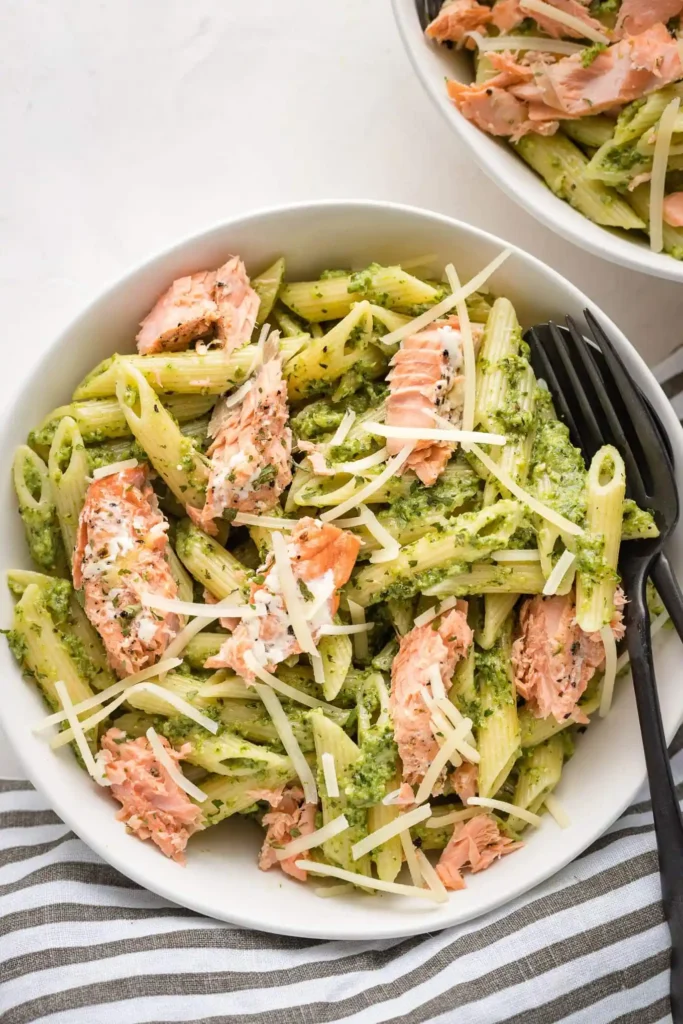
- Don’t overcook salmon. Take care not to overcook your salmon because it will only remain buttery, juicy and tender as long as it isn’t overcooked. Salmon should be undercooked than overcooked, in my opinion. Make sure to check your salmon at the early part of the doneness window, especially if your salmon is on the thin side. If your salmon is uneven like my freshly caught salmon was, you may need to remove the thin side from the oven before the much thicker side.
- Don’t flake salmon too small. The salmon will continue to break apart as it’s tossed in the pasta, so don’t break it apart too much initially, or you’ll be left with super small pieces. You can also top the pasta with chunks of salmon if you prefer.
- Let the pasta rest before serving. Letting the dish rest briefly before serving allows the flavours to develop and the sauce to thicken.
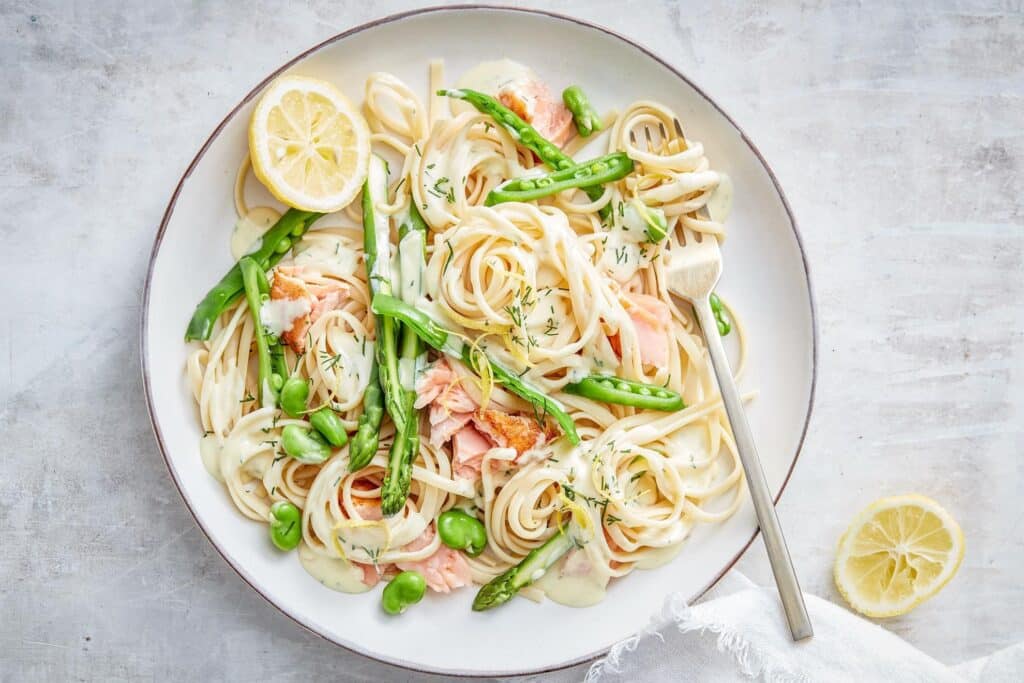
What to Serve with Salmon Pasta
When serving salmon pasta, it’s essential to pair it with complementary side dishes that enhance the overall dining experience. By choosing the right accompaniments, you can create a well-balanced and satisfying meal
1. Green Salad
A fresh green salad is an excellent choice to serve alongside salmon pasta. It adds a refreshing element to the meal and balances out the richness of the creamy pasta. Use a mix of greens like baby spinach, arugula, or mixed salad leaves. Add cherry tomatoes, cucumber slices, thinly sliced red onions, and maybe some avocado for extra creaminess. You can also toss in some toasted nuts or seeds for crunch. Dress the salad with a light vinaigrette made of olive oil, balsamic vinegar, Dijon mustard, a touch of honey, salt, and pepper.
2. Garlic Bread
Garlic bread is a classic side that pairs well with any pasta dish. Slice a baguette or Italian bread lengthwise, then spread a mixture of softened butter, minced garlic, chopped parsley, salt, and pepper over the cut sides. Broil in the oven until the edges are golden and the bread is crispy. Serve the warm garlic bread on the side to complement the flavours of the salmon pasta.
3. Steamed Vegetables
Steamed vegetables are a healthy and light addition to the meal. Broccoli, asparagus, and green beans are great options. Simply trim and clean the vegetables, then steam them until they are tender-crisp. Season with a sprinkle of salt and a drizzle of olive oil.
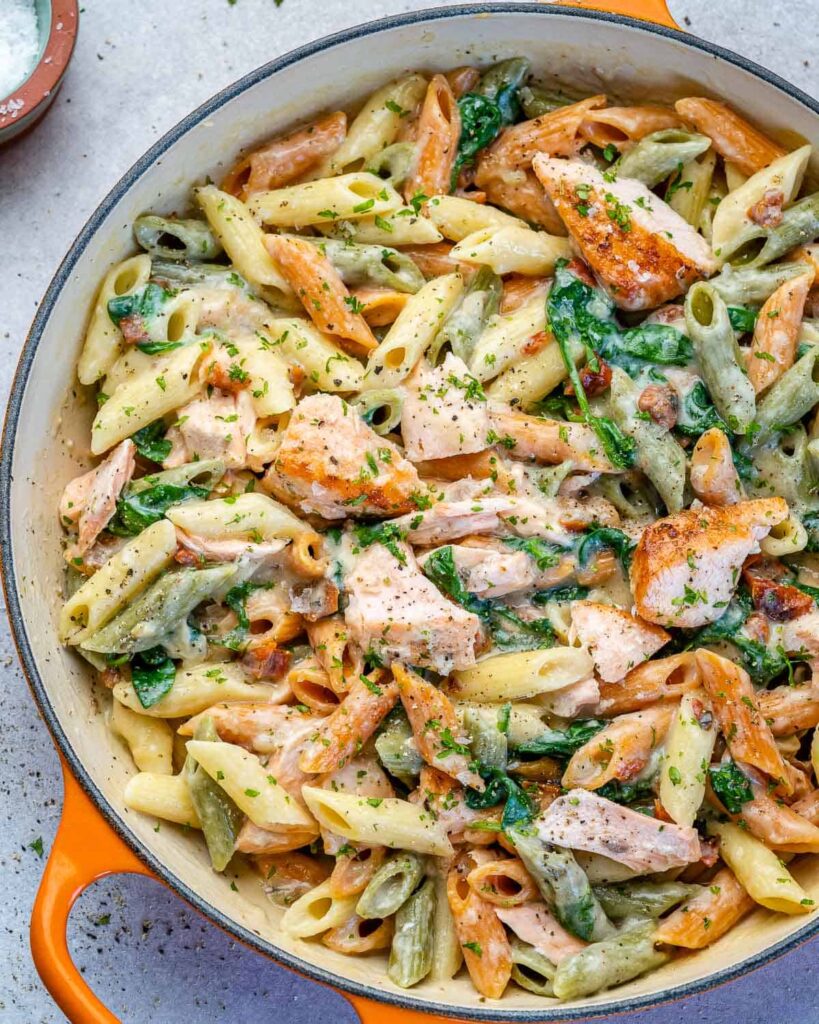
4. Roasted Vegetables
Roasting vegetables intensifies their flavours and creates a delicious caramelization. Choose vegetables like carrots, zucchini, bell peppers, or cherry tomatoes. Toss them in olive oil, salt, pepper, and your favourite herbs, then roast them in the oven until they are tender and slightly browned. Roasted vegetables add warmth and earthiness to the meal.
5. Lemon Wedges
Serve some lemon wedges on the side of the salmon pasta. The acidity of the lemon cuts through the richness of the creamy pasta and enhances the flavour of the salmon. Squeezing a little lemon juice over the pasta just before eating can brighten up the dish and provide a tangy kick.
6. Caesar Salad
A classic Caesar salad can be a delightful accompaniment to salmon pasta. Use crisp romaine lettuce, Caesar dressing, homemade croutons, and grated Parmesan cheese. You can also add some grilled chicken or shrimp to the salad for an extra protein boost. The savoury and tangy flavours of the Caesar salad complement the creamy pasta perfectly.
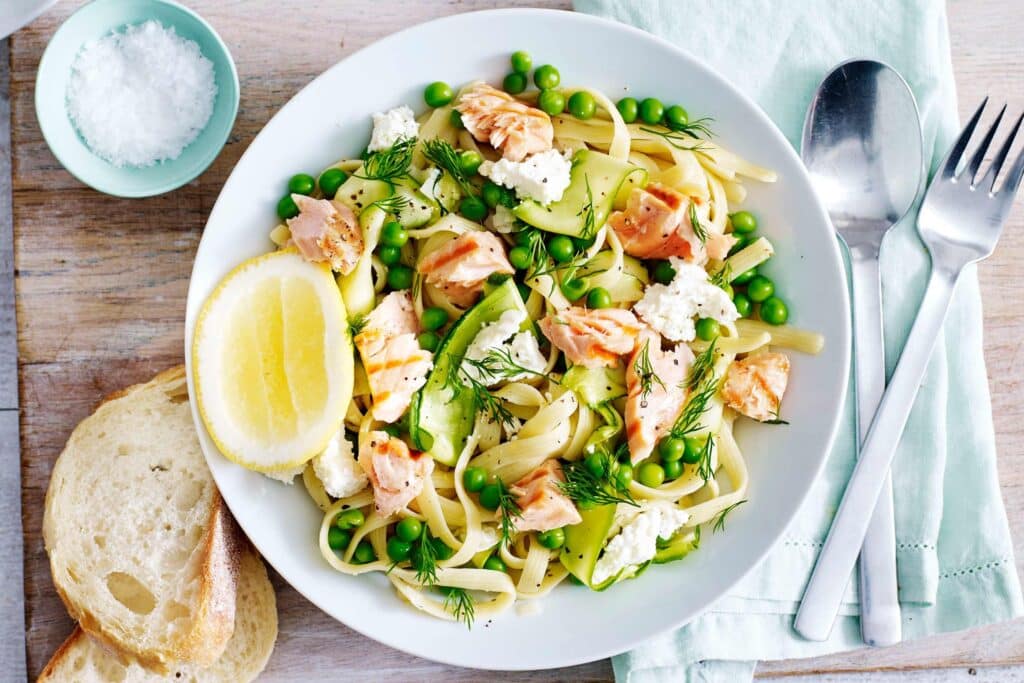
7. Caprese Salad
Caprese salad is a simple yet flavorful side dish. Arrange sliced tomatoes, fresh mozzarella, and basil leaves on a platter. Drizzle with balsamic glaze and a little olive oil, then sprinkle with salt and pepper. The combination of ripe tomatoes, creamy mozzarella, and fragrant basil creates a wonderful balance of flavours.
8. Bruschetta
Bruschetta is a delicious Italian appetizer that can also be served as a side dish. Prepare diced tomatoes mixed with minced garlic, fresh basil, olive oil, balsamic vinegar, salt, and pepper. Toast slices of baguette or Italian bread until crispy, then top each slice with the tomato mixture. The burst of fresh tomato flavour complements the salmon pasta nicely.
9. Spinach Salad
A spinach salad with sliced strawberries, crumbled feta cheese, and a balsamic vinaigrette is a lovely side dish to serve with salmon pasta. The combination of sweet and tangy flavours from the strawberries and balsamic dressing, along with the saltiness of the feta, creates a delightful contrast.
SEE ALSO: Korean Corn Dog Home-made Recipes you could Try
Health Benefits of Salmon
Salmon is a popular oily fish that contains good fats. This makes it good for heart health and cholesterol. A good amount of protein, vitamins, minerals, and omega-3 and -6 fatty acid content contributes to overall health.
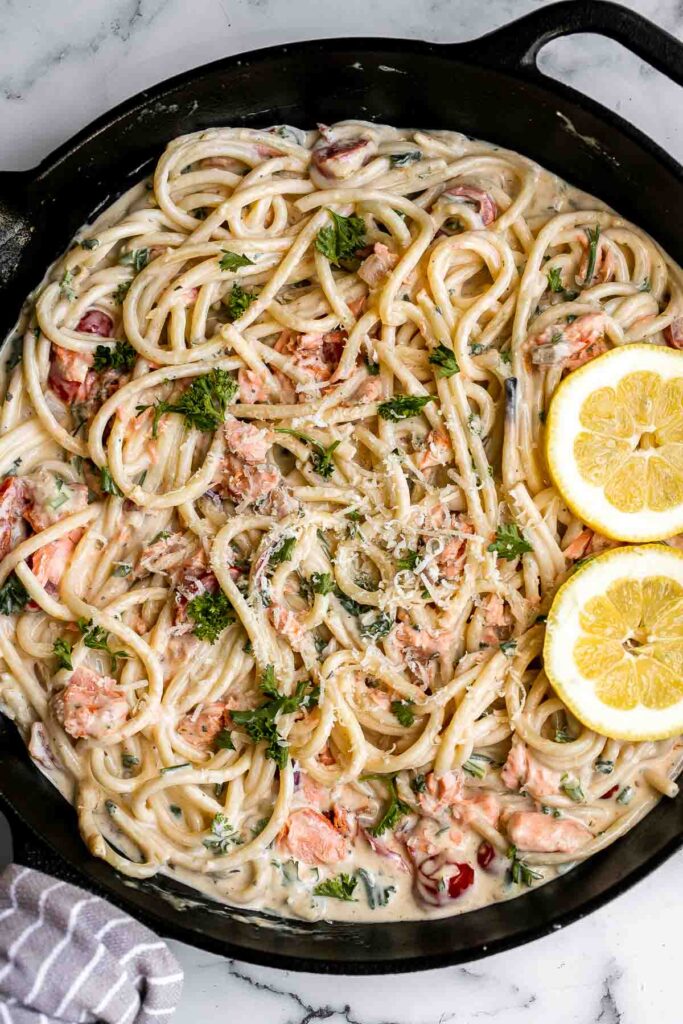
1. Improves Cardiovascular Health
Salmon is a rich omega-3 fatty acids (EPA and DHA) and potassium source. The omega-3 and -6 fatty acids combined with potassium greatly contribute to heart health, as they reduce artery inflammation, lower cholesterol levels, and maintain blood pressure levels. Potassium helps to control blood pressure and prevent excess fluid retention.
2. Promotes Brain Health
Eating salmon during pregnancy can assist with improved fetal brain development and health. The vitamin A, vitamin D, and selenium in salmon boost and improve brain function. In fact, omega-3 fatty acid supplements are used to treat psychological disorders like Alzheimer’s and Parkinson’s disease.
3. Fights Joints inflammation
Salmon contains a group of small proteins called bioactive peptides. Bioactive peptide increases, regulates, and stabilises collagen synthesis in human osteoarthritic cartilage. The omega-3 fatty acids in salmon help to reduce various inflammatory joint conditions, including osteoarthritis.
4. Promotes Healthy Skin
Salmon benefits the skin due to fatty acids and vitamin A. These healthy fats improve skin quality and health. Omega-3 fatty acids work in collaboration with the carotenoid antioxidants of astaxanthin in salmon to tremendously reduce free radical damage that is responsible for ageing.
5. Helps with weight Loss
Salmon may benefit weight loss as well. Oily fish is protein-rich with a low-calorie content. Therefore, it is absolutely healthy and advisable to include salmon in your diet plan, as it will provide you with huge amounts of protein and compensate for various vitamin and mineral deficiencies in the body.
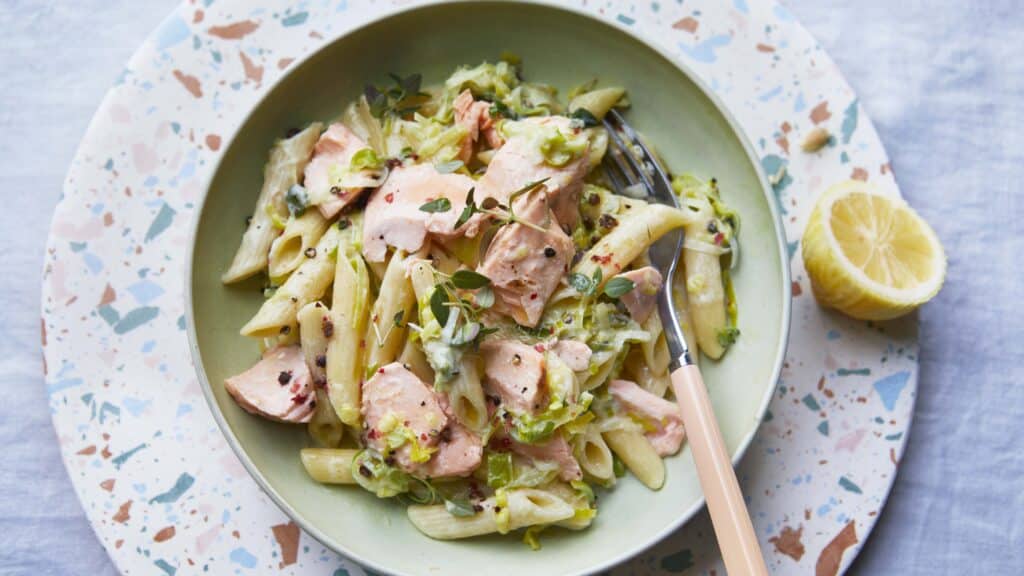
6. Helps to enhance the eyesight
Incredibly rich in omega-3 fatty acids and vitamin A, salmon is a wonderful food source for the eyes. Regular salmon consumption could help to cure dry-eye syndrome and age-related macular degeneration (AMD) symptoms.
7. It may help cure cancer
Certain conditions like skin cancer, prostate cancer, colorectal cancer, liver cancer, UVB-induced skin cancer, and brain tumours may be treated and prevented with omega-3 fatty acids. Due to the impressive omega-3 fatty acid content, salmon is considered a superfood. It is medically proven that omega-3 fatty acids can profoundly affect cancer cells and kill tumours.
8. Repairs body worn-out tissue
Salmon helps the body to build and repair tissues after an injury, protects bone health, and maintains muscle mass during weight loss. It also maintains a healthy metabolic rate and improves bone density and strength. Salmon is a good protein source, an essential nutrient that the body requires as it is the building block for bones, muscles, cartilage, skin, and blood.
9. Helps in Proper Thyroid Function
One of the important functions of selenium is to maintain proper thyroid function. A decent portion of salmon can provide a considerable amount of selenium. This essential trace mineral protects the thyroid gland from oxidative damage caused during the synthesis of the thyroid hormone. The cells of the thyroid gland produce hydrogen peroxide, which is used to make the thyroid hormone.
10. Contains Anti-oxidant Properties
The pink colour of the salmon comes from the presence of astaxanthin, a member of the carotenoid family of antioxidants. Unlike other carotenes and carotenoids, astaxanthin doesn’t convert to retinoids in the human body. It is an antioxidant by nature and is good for preventing cardiovascular, immune, inflammatory, and neurodegenerative diseases.
SEE ALSO: How to make Egg fried Rice: Best Egg Fried Rice Recipes
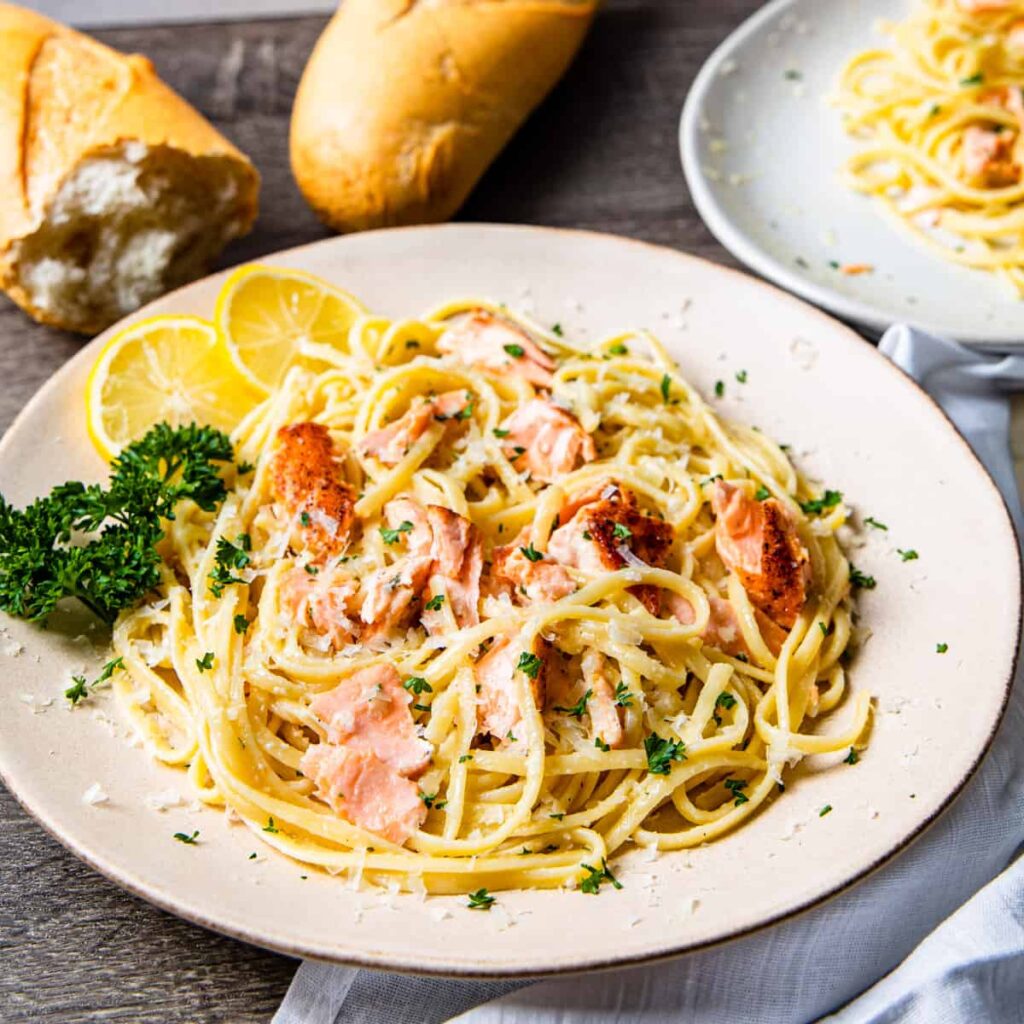
Conclusion
Salmon Pasta is a delectable culinary experience that brings together the best of both worlds: tender salmon and perfectly cooked pasta enveloped in a rich, creamy sauce with a refreshing hint of lemon and the aromatic appeal of fresh herbs.
This recipe allows you to create a satisfying meal in no time, making it a go-to for both weeknight dinners and special occasions.
By following these simple steps, you can easily whip up this delicious dish that will impress your family with its incredible flavours. The versatility of salmon pasta also means you can experiment with different ingredients, adding your personal touch to suit your taste preferences.
So, if you are simply seeking a delightful pasta variation, the Salmon Pasta recipe is sure to be a hit at your dining table. Serve it with a side of green salad and a glass of chilled white wine for a complete and satisfying meal that will leave you longing for more.
FAQs
What kind of pasta goes with salmon?
Creamy Garlic Pasta.
Lemon Pasta.
Garlic Butter Pasta.
Cream Cheese Pasta.
Macaroni Pasta Salad.
Creamy Mushroom Pasta.
Pasta with peas.
What does salmon go best with
Lemon Butter Pasta.
Coconut Rice.
Sautéed Garlic Green Beans.
Lemon Kale Salad.
Mashed Red Potatoes.
Cacio e Pepe.
Roasted Brussels Sprouts Salad.
Cilantro Lime Rice.
Can you pan-fry salmon?
Rub salt, pepper and oil onto salmon skin just before cooking. Place a frypan over medium heat. Place salmon portions skin side down on a frypan for 5 mins. Turn salmon portions and cook for 5 mins or to your liking.
What do you cook salmon in?
Preheat the oven to 450 degrees F. Season salmon with salt and pepper. Place salmon, skin side down, on a non-stick baking sheet or in a non-stick pan with an oven-proof handle. Bake until salmon is cooked through, about 12 to 15 minutes.
